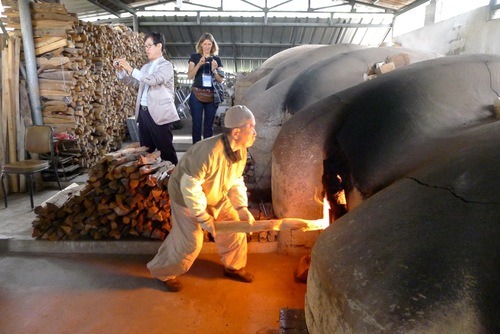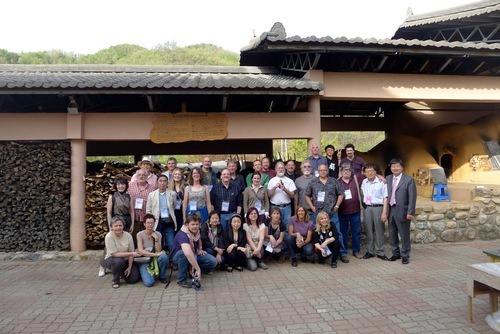Mungyeong Traditional Tea Bowl Festival
By Shamai Sam Gibsh & Stephanie Young
A movie set, created in the style of a sixth century village, within forests and farmland, cherry blossom and azaleas, in valleys and mountains centrally located in South Korea, is the stage for this amazing Mungyeong Tea Bowl Festival. The City of Mungyeong and the South Korean government sponsor the festival, now in its eighth year, and focus on reviving Korean Tea ceremony traditions, as well as the ceramic ware made for it.
Ceramic artists (28) from all over the world were invited this year (2012) to participate in this festival, and to display their tea bowls and demonstrate their techniques, as well as to join local artists in various activities related to the traditional Tea Bowl ceremonies.
Our tea bowls were available for show and sale, and some selected tea bowls were entered into a competition and are now part of the Mungyeong Tea Bowl Museum’s permanent display, alongside the local artists collection. The museum also includes a large studio and teaching center and an impressive traditional Korean Noborigama kiln.
There were many buildings filled with about 50 local masters and potters, selling traditional or modern artistically interpreted Korean wares. There were of course many buildings holding traditional tea ceremonies, for the casual afternoon sip or a more extended, fully traditional affair.

We watched artists fire a Noborigama kiln as it has been fired for thousands of years. Local clay and raw materials transformed into wares of the same timelessness as it has been done for centuries. The Mungyeong area is the center of tea bowl making in South Korea and there are many very talented masters, each with his own studio and at times a large display room and even a museum.
One such artist is Oh Soon-Taek, a self taught ceramicist who originally began his creative endeavors as a painter; he learned the nature of the medium “from the world”. Some of the most striking pieces among his collection were the very small, almost miniature tea sets, each executed with perfect craftsmanship. We were fortunate to join Oh Soon-Taek for tea ceremony on a number of occasions, to see the inherent beauty of his work as it fulfilled its function. He masters a variety of glazes and forms in his collection, leaning more to simple aesthetics, so one can admire the form and function of his meditative work, and appreciate his respect to traditional ware, in spite of the adaptation to modern life. Oh Soon-Taek makes his own clay and glazes from the nature around his house, and he built his own kiln. He sells his work only from his house and workshop and has a solo exhibition once every 10 years.

Our hosts went to a great effort to bring us to a number of potteries and kiln sites further spread through the countryside. One such visit was to the studio of Han-Bong Cheon. Our busload of international artists came upon a small, slight man of 80, stocking an enormous Noborigama kiln with the ferocity of a teenage apprentice. Han-Bong Cheon, who became an Intangible Cultural Treasure in 1996, and his daughter Kung Hee Cheon have been making tea ware at their home outside of Mungyeong for 64 years. Tea ceremony has been historically conducted by monks in the Buddhist temples, where Han-Bong Cheon learned and mastered it. Han Bong’s mission was to reintroduce to South Korea the know how of the old Koryo tea bowl tradition, that was at its peak production during the 17th century and was lost during the introduction of mass production.
He is also considered today as the artist who revived the Maksabal - “Bowl for Anything” - made for all purposes. Koreans use Maksabal as a bowl for water, soup and tea, appreciating its endless and enduring value. In addition, in order to perfect it, he traveled to Japan to learn the making of tea wares from Mr. Tokuro from Setto Mino. Han-Bong Cheon’s work masterfully explores the reserved aesthetics of Korean tea ware. His daughter Kung Hee Cheon displayed and sold both hers and her father’s wares at the festival. Her work adds a feminine touch and an additional dimension to the traditional male craft.
Another, of many, amazing places we visited was the home, studio, and gallery of Professor Tae-Keun Yoo. Professor Yoo, as we call him, teaches ceramics at the local university, and at most times was accompanied by a group of devoted young potters-students. Unlike many of the self taught or apprenticed potters in the area, Professor Yoo added a hard won university degree in his pursuit of ceramic mastery. As a child from an undeveloped farmland with an amazing desire to learn and develop, he managed to study and graduate high school, go to university and to Japan. The vast display of his work in his gallery encompassed many intertwined aesthetics of traditional Korean wares, Japanese forms and glazes, and a more westernized exploration of color and design. Professor Yoo took the strong foundation of traditions of Korean ceramics and used it as a springboard for creative exploration. When searching for inspiration, he spends a lot of time among monk friends, mainly in the Bongam temple, one of the most amazing sites, which he showed us. His work varied from tiny bowls to moon jars, luster to unglazed raw clay. There were sculptures displayed casually amongst tea wares. Professor Yoo seems to be exploring the ceramic arts, as much so as the ceramic function, a concept commonplace to us though radical for the area.
The Mungyeong Traditional Tea bowl Festival is an incredible learning experience for all those fortunate enough to be invited. Beyond learning the traditional Korean aesthetics and admire the efforts of the South Korean government to keep ceramic tradition alive, each artist has the tremendous opportunity to learn from their accompanying colleagues, some of the best ceramic artists in their own country. Finally, it is important to mention Mr. Charlie Young who is a ceramic collector and an enthusiastic person that makes it possible for the foreigners who are invited by the city officials and the local Ceramic Society to have the best of times during this festival.

List of international participants in 2012: Adam Frew (N. Ireland), Antonella Cimatti (Italy), Douglass Black (USA/Japan), Genevieve Meylan(Swiss), Katsutaro Kikuchi (Japan), Partricia Cassone (France), Roland Summer (Austria) Touri Maruyama( Japan), Andrew Walford (S. Africa), Craig Edwards (USA), Elena Renker (New Zealand), Jeff Brown (USA), Lee Love (USA), Matthias Kaiser (Austria), Phillip Pollet (USA), Shamai Sam Gibsh (Israel), Stephanie Young (USA), Anne Mette Hjortshoj (Denmark), Dicle Oney (Turkey), Fergus Stewart (Scotland), John Baymore (USA), Lui Xiao Yu (China) Michael Alan Martino (USA/Japan), Rebecca Maeder (Swiss), Stephan Schwarz (Austria), Tom Decker (USA).
Shamai Sam Gibsh and Stephanie Young are both affiliated with the Harvard Ceramic program in Boston MA, USA.
Published in Ceramics Now Magazine Issue 2.
